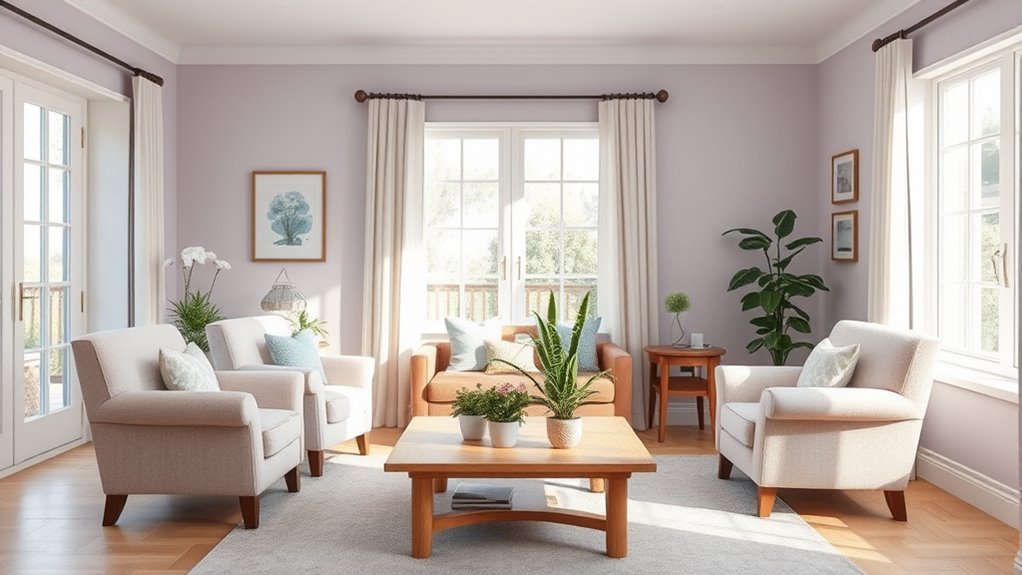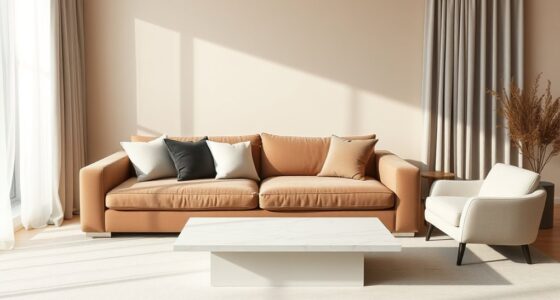To create soothing color palettes for senior living spaces, choose soft, muted tones like gentle blues, warm neutrals, and earthy greens that promote calmness and comfort. Incorporate natural hues like terracotta and Pesto green to foster a connection to nature, boosting emotional well-being. Balance warm and cool tones for harmony and safety, using high-contrast schemes for easy navigation. Exploring refined color strategies can help you craft inviting environments that support residents’ peace and safety—learn more to optimize your space.
Key Takeaways
- Opt for soft, muted tones like gentle blues, warm beiges, and earthy greens to create calming, stress-reducing environments.
- Incorporate nature-inspired hues such as Pesto green and terracotta to foster tranquility and a connection to the outdoors.
- Balance warm and cool neutrals to enhance visual harmony and make spaces feel inviting and safe.
- Use high-contrast color schemes for wayfinding and safety, combining dark furniture with light walls for clarity.
- Add tactile textures like linen and wood alongside soothing colors to promote emotional comfort and sensory engagement.
The Role of Color in Enhancing Well-Being for Seniors

Color plays a pivotal role in supporting seniors’ well-being by creating calming and comforting environments. When you choose the right color, you make the space feel less stressful and more inviting. Soft blues and muted earth tones can reduce anxiety and help residents feel more relaxed.
Incorporating natural-inspired colors like Pesto green or terracotta makes the interior feel connected to nature, which supports a sense of peace and tranquility. Warm neutrals and gentle jewel tones make the room feel safe and cozy, promoting emotional comfort.
Strategic use of calming color can also make a room feel more spacious and welcoming. Additionally, remote hackathons can serve as innovative platforms for designers and healthcare professionals to collaborate on creating effective, accessible color schemes and interior solutions for senior living spaces. Understanding the importance of contrast ratio can help in selecting colors that improve visibility and safety for residents, especially those with visual impairments. Overall, the right color choices help residents feel at ease, positively impacting their mood, sleep, and mental health in senior living communities.
Choosing Calm and Inviting Color Palettes
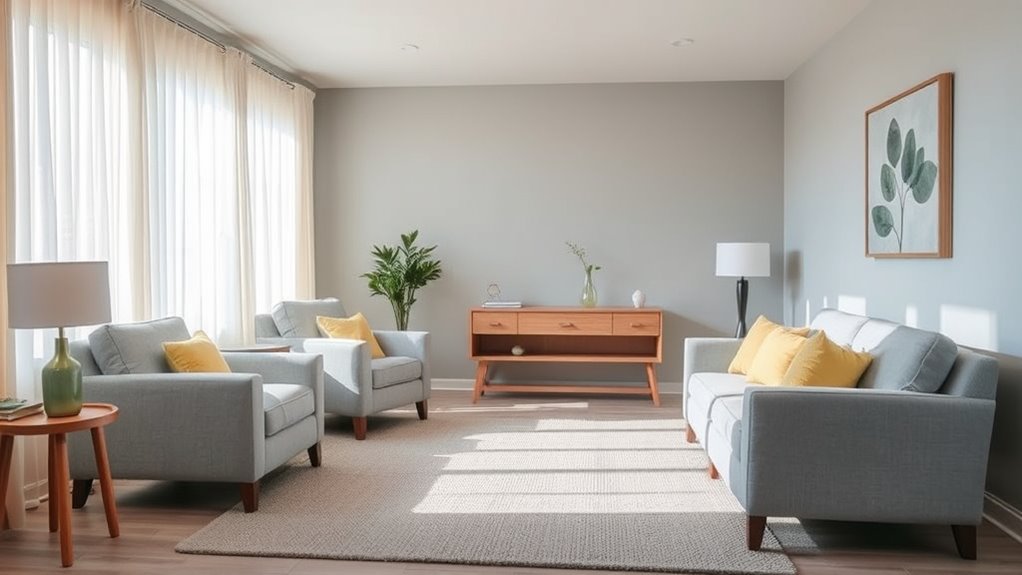
Selecting the right color palette is key to creating a calm and inviting environment in senior living spaces. Use soft, muted tones like gentle blues, warm beiges, and earthy greens to reduce stress and make each room feel relaxing. Incorporating a balanced mix of cool and warm neutrals helps craft a living environment that feels welcoming and homelike. Colors inspired by nature, such as Pesto green or terracotta, foster a connection to the outdoors, supporting emotional well-being. Strategic placement of calming shades in bedrooms, lounges, and hallways reinforces a peaceful atmosphere. Additionally, understanding how color psychology can inspire creative solutions encourages thoughtful design choices that enhance tranquility. Considering how emotional well-being is influenced by color choices can help create spaces that promote comfort and serenity. Using aesthetic wall organization ideas can also contribute to a clutter-free, serene environment that further promotes relaxation.
Incorporating Nature-Inspired Hues for Tranquility
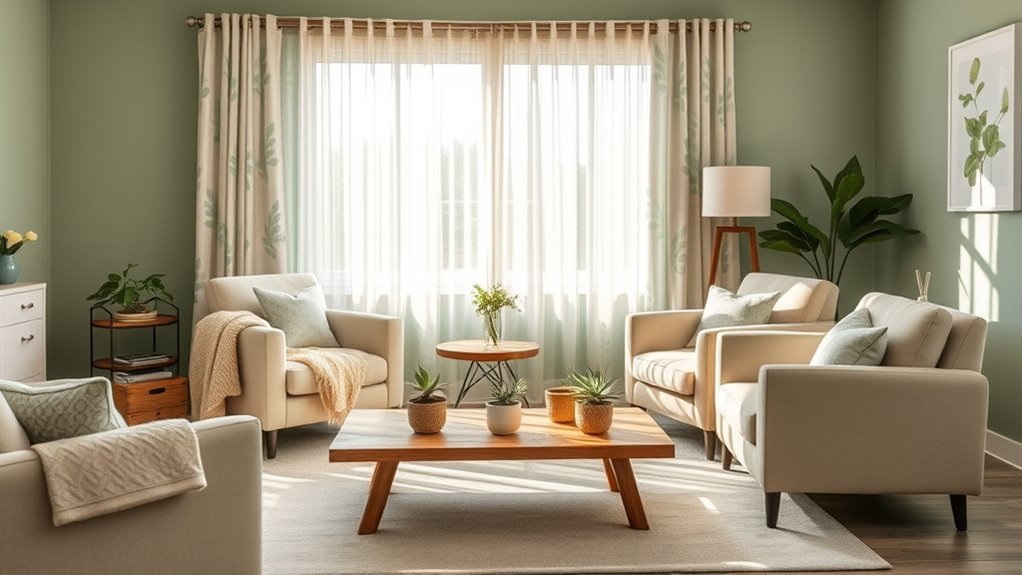
Incorporating nature-inspired hues into senior living spaces can considerably enhance tranquility and emotional well-being. These colors, such as moss, sage, and warm terracotta, foster a connection to nature that promotes relaxation and reduces stress. Soft, muted shades drawn from natural landscapes create calming environments that support emotional stability and cognitive health. Using botanical colors in wall paint and textiles encourages a tranquil atmosphere, helping residents feel more centered and at ease. Layering natural hues with organic textures like wood and linen amplifies their restorative effects. To maximize impact, consider: – Incorporating earthy green tones in walls and furniture – Using warm terracotta accents for warmth and comfort – Adding botanical patterns in textiles – Combining natural hues with organic textures – Incorporating subtle, muted shades for a soothing environment – Recognizing the importance of tableware in creating welcoming dining settings that complement the tranquil atmosphere. Additionally, mindful arrangement of decorative elements can enhance a peaceful ambiance and foster a sense of harmony within the space.
Balancing Warm and Cool Tones for Comfort
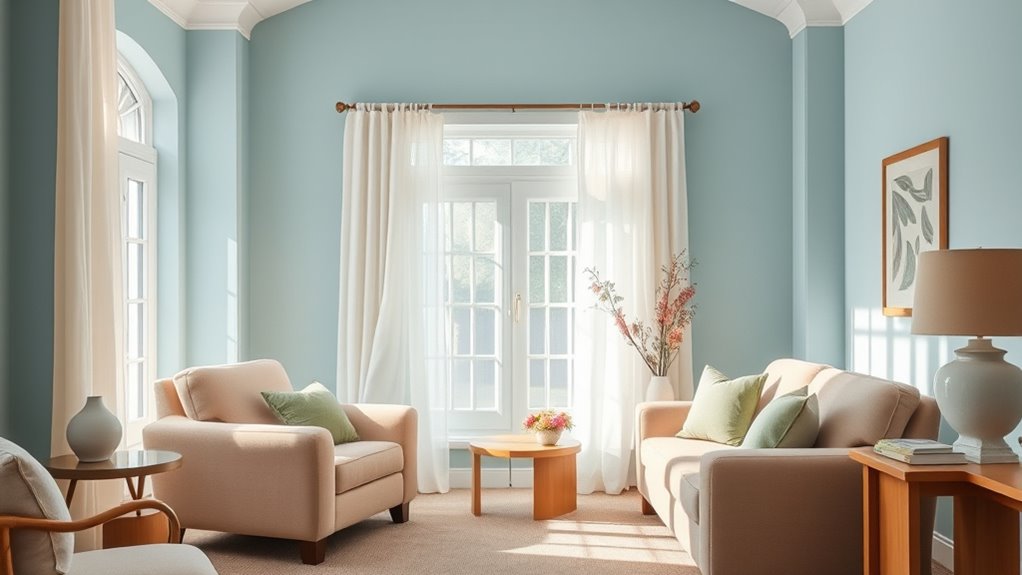
Balancing warm and cool tones creates a comfortable, inviting environment that feels both calming and lively. You can improve visual harmony by thoughtfully layering colors in walls, textiles, and accessories. When done well, this balance guides attention and fosters a sense of stability for senior residents. Incorporating self watering plant pots into the space not only adds greenery but also ensures plants remain healthy and vibrant with minimal maintenance. These pots often feature watering tools that are ergonomic and easy to handle, further simplifying plant care for caregivers and residents alike, especially in environments emphasizing rustic decor and natural elements. Additionally, understanding business diversification strategies can help care facilities explore new ways to enhance residents’ environments and services. Utilizing benefits of wood-burning concepts, such as incorporating renewable and sustainable features, can further enhance the comfort and eco-friendliness of senior living spaces.
Harmonizing Color Temperatures
Creating a comfortable senior living space involves thoughtfully blending warm and cool tones to foster a soothing atmosphere. When you balance these temperature contrasts, you create an environment that feels inviting yet calming, reducing overstimulation. color temperature considerations influence how residents perceive space and can be used to enhance emotional well-being in design choices. Use warm hues like terracotta or soft beiges alongside cool shades such as muted blues or sage green to enhance comfort and visual interest. Properly harmonized color temperatures can also influence how residents perceive space, making rooms feel more expansive or cozy as needed. In addition, mindful placement of colors can help in creating designated zones that promote relaxation or activity within the space. Incorporate neutral palettes with subtle warm or cool accents for a balanced look that supports emotional well-being. By understanding the psychological effects of color temperature, you can design spaces that promote relaxation, safety, and a true sense of home for seniors. Recognizing the influence of visual perception can further refine your color choices, creating environments that evoke serenity and comfort. Additionally, considering how dog breeds can influence design choices can help tailor spaces to specific needs, fostering a more personalized environment for residents. Considering how auras reflect emotional and spiritual states can also inform your color selections to further enhance the environment. Moreover, understanding the vetted nature of resources and products used in design can ensure safety and quality in senior living environments.
Enhancing Visual Balance
Achieving visual balance in senior living spaces involves carefully combining warm and cool tones to foster comfort and harmony. By pairing warm colors like terracotta and amber with cool hues such as soft blues and muted greens, you create a harmonious environment that enhances comfort and reduces visual fatigue. Incorporating color theory principles like complementary or analogous schemes helps achieve visual equilibrium. Strategically placing warm colors in social or activity areas and cool tones in private or restorative zones visually delineates spaces while promoting emotional well-being. Evidence suggests that a balanced color palette with a 60-30-10 ratio of warm, cool, and neutral tones optimizes visual comfort, fostering a sense of stability and security for residents. Additionally, understanding color psychology can guide the selection of hues that evoke feelings of calm and reassurance, further supporting residents’ emotional health. Recognizing the importance of adaptability in design allows spaces to evolve with residents’ changing needs and preferences, ensuring ongoing comfort. Keeping in mind the financial impact of well-designed environments can also motivate investment in thoughtful color schemes that enhance quality of life.
Creating Inviting Atmospheres
In senior living spaces, combining warm and cool tones thoughtfully can transform an environment into an inviting, comfortable haven. Balancing these hues creates harmony that promotes relaxation and well-being.
Use warm tones like terracotta and beige in communal areas to encourage social interaction. In contrast, cool hues such as muted blues and greens in private spaces foster calm and rest.
Incorporating soft neutrals with subtle pops of color prevents overstimulation while maintaining visual interest. Layering warm and cool shades through accessories, textiles, and accent walls gives you a versatile palette adaptable to different lighting and needs.
Additionally, integrating candles can add a warm, calming glow that enhances the cozy atmosphere without overwhelming the space. This strategic approach helps residents feel safe, cozy, and tranquil, enhancing their overall experience in the space.
- Use warm tones for social zones to promote connection
- Apply cool hues in private, restful areas
- Incorporate neutral shades for balance
- Add pops of color for visual interest
- Layer colors through textiles and accessories
Using Color to Support Navigation and Safety
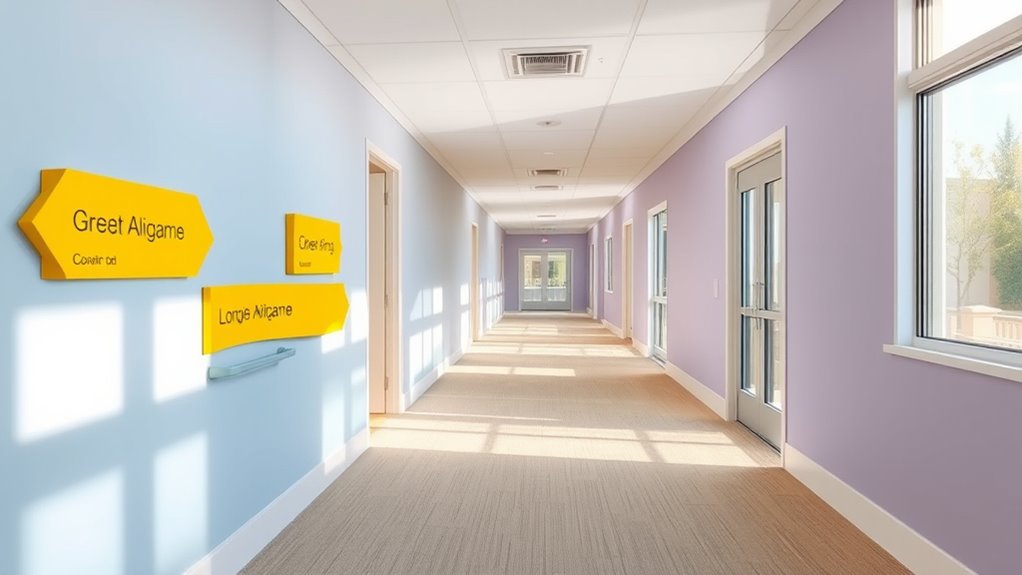
Using color strategically can make a big difference in how residents find their way and stay safe. You can improve navigation by applying contrasting colors to walls, doors, and signage, making key areas easy to identify. Incorporating color psychology principles can also enhance the calming and comforting atmosphere for residents. Clear, consistent color coding around safety features and high-visibility elements also helps prevent accidents and quickens emergency responses. Implementing wicking materials in signage or safety markings can further improve moisture resistance and durability, ensuring long-lasting clarity. Additionally, utilizing hydrogen safety features in design can contribute to overall safety by alerting residents and staff to potential hazards related to energy sources.
Color Coding for Wayfinding
Color coding plays a vital role in helping residents navigate senior living spaces safely and efficiently. By assigning distinct colors to different areas or pathways, you make navigation more intuitive and reduce confusion.
Using high-contrast combinations, like dark text on light backgrounds, enhances visibility for residents with visual impairments.
Strategic placement of colors at eye level or near doorways helps residents quickly identify essential zones such as exits, dining areas, or restrooms.
Consistent color schemes across related spaces reinforce spatial memory, supporting independence.
Incorporating universally recognized cues, like green for safety or red for caution, promotes safety and clear communication throughout your community.
- Assign different colors to key areas for easy recognition
- Use high-contrast colors for better visibility
- Place color cues near doorways and eye level
- Maintain consistent color schemes throughout spaces
- Apply universal color signals for safety
Contrasting Elements Enhance Safety
Contrasting elements in color are essential for enhancing safety and supporting navigation within senior living spaces. Using high-contrast schemes, like dark doors against light walls, helps residents find their way easily and reduces fall risks. Strategic contrasts in flooring and wall colors clearly define boundaries and level changes, preventing accidents. Brightly colored handrails and signage improve visibility, making wayfinding intuitive and fostering independence. Emphasizing contrast on stair edges and step risers heightens awareness, decreasing trip hazards. Color differentiation in furniture and fixtures guides residents naturally through shared spaces, boosting confidence and safety.
| Feature | Contrast Type | Benefit |
|---|---|---|
| Doors and Walls | Dark vs. Light | Easier navigation |
| Flooring and Walls | Different Colors | Clear boundaries and levels |
| Handrails and Signage | Bright Colors | Enhanced visibility |
| Stair Edges and Risers | Contrasting Hues | Prevents trips |
| Furniture and Fixtures | Color Differentiation | Guides movement, supports safety |
Clear Signage With Color
Clear signage with thoughtfully chosen colors plays a vital role in supporting safe navigation within senior living spaces. Using high-contrast colors enhances visibility and legibility, making signs easier to read for residents with visual impairments.
Color-coded pathways and zones help residents quickly identify different areas, reducing confusion and promoting independence. Bright or warm-colored signs placed at key decision points improve orientation and safety during movement.
Consistent use of specific colors for destinations like restrooms or exits reinforces wayfinding cues, helping residents remember routes. Additionally, calming, familiar hues in signage create a reassuring environment, minimizing navigation-related anxiety.
- Use high-contrast colors for maximum visibility
- Implement color-coded zones for easy navigation
- Place bright signs at key decision points
- Maintain consistent colors for important destinations
- Choose soothing hues to promote calmness
Trend-Driven Colors for Modern Senior Spaces
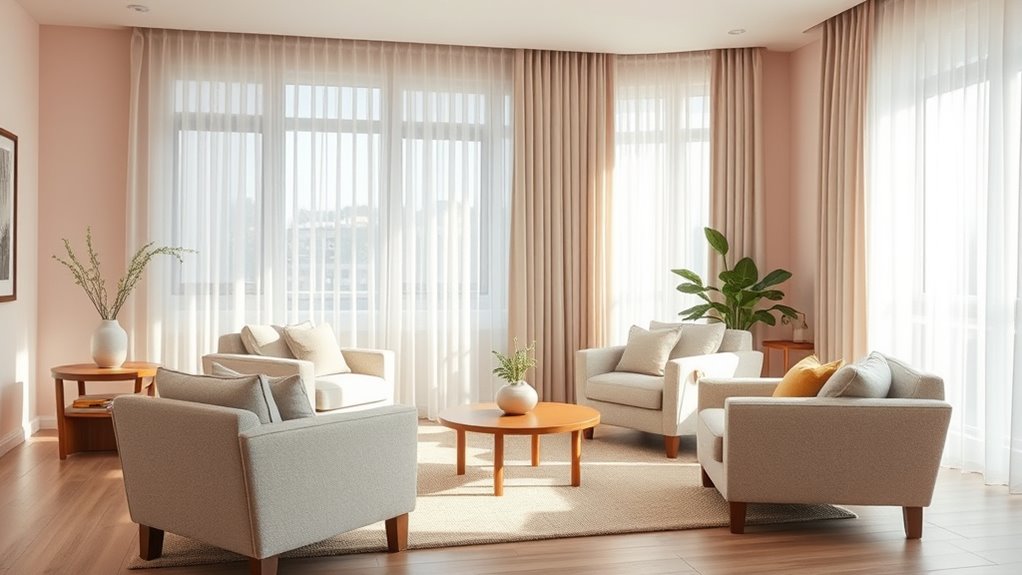
In modern senior living spaces, trend-driven colors like Pesto—a vibrant, rich green—are becoming essential for creating lively, welcoming environments. This color symbolizes vitality, nature, and wellness, aligning with current design trends. When paired with neutrals such as beiges, terracotta, and muted blues, Pesto helps craft harmonious, timeless interiors that feel both modern and comforting. These palettes emphasize vibrant atmospheres that foster comfort and community. Industry experts suggest blending contemporary hues with classic elements to produce spaces that are stylish yet emotionally uplifting for residents.
| Trend-Driven Colors | Design Impact |
|---|---|
| Pesto (Rich Green) | Evokes vitality, connection to nature |
| Neutral Tones | Creates balance, timeless appeal |
| Vibrant Palettes | Enhances social engagement |
| Modern Influences | Supports functionality and style |
| Classic Elements | Uplifts emotional well-being |
Tips for Applying Soothing Colors Effectively
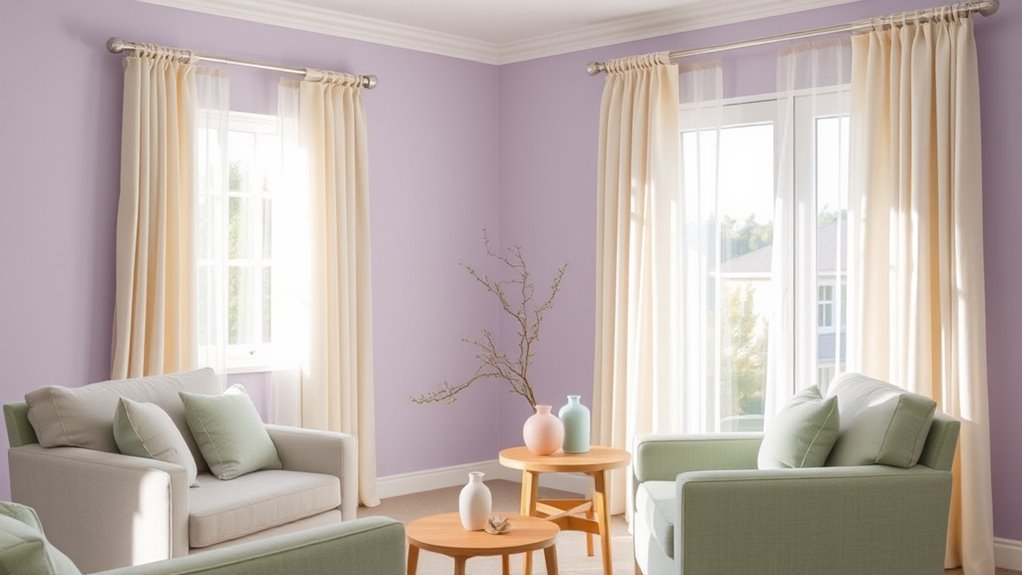
To create a calming environment in senior living spaces, selecting and applying soothing colors thoughtfully is essential. You should incorporate soft, muted hues like pastel blues, gentle greens, and warm neutrals to promote relaxation and reduce stress.
Use color psychology research to choose palettes that evoke safety and tranquility, such as lavender or sage, which help lower anxiety. Apply these colors strategically in high-traffic and communal areas to foster peace and support residents’ well-being.
Balance calming hues with natural light and tactile textures to enhance comfort and create a homelike atmosphere. Keep color schemes harmonious by limiting overly bright or saturated colors.
- Focus on soft, muted hues for walls and accents
- Use calming colors in communal and high-traffic areas
- Pair soothing colors with natural light and textures
- Avoid overly bright or intense shades
- Layer colors for depth and emotional stability
Frequently Asked Questions
What Color Is Calming for the Elderly?
When choosing calming colors for the elderly, you should focus on soft, muted shades like gentle blues, sage greens, and warm neutrals.
These hues help reduce stress, lower blood pressure, and promote relaxation.
Avoid bright or overly saturated colors, and instead opt for pastel tones and earth shades.
These colors create a safe, familiar environment that supports emotional well-being and comfort, making residents feel more at ease in their space.
What Is the Best Color Palette for Seniors?
You might think bold, bright colors are best, but the truth is, a calming palette works wonders for seniors. You should choose soft, muted tones like gentle blues, earthy greens, and warm neutrals. These colors promote relaxation and emotional well-being.
Add subtle pops of color for wayfinding, and stick to natural hues for tranquility. This balanced approach helps create a welcoming, adaptable environment that supports mental health and comfort.
What Are the Calming Colors for Living Rooms?
When choosing calming colors for living rooms, opt for soft blues and muted greens, as they promote relaxation. Light neutrals like beige, taupe, and pale gray help create a peaceful atmosphere.
Incorporate gentle lavender or lavender-gray tones to evoke serenity. Warm earthy shades such as soft terracotta and muted browns add coziness.
Using pastels and layered textures enhances visual softness and reduces sensory overload, making the space inviting and calming.
What Color Is Good for the Elderly?
You’re asking what color is good for the elderly, and your question is essential because the right choice can transform their space into a haven.
Soft, muted tones like gentle blues, greens, and warm neutrals are perfect—they promote calmness and reduce eye strain.
Avoid bright, saturated colors that can overwhelm.
Instead, opt for pastels and earth-inspired hues, creating a soothing environment that feels familiar, safe, and comforting for seniors.
Conclusion
By thoughtfully choosing soothing colors, you create a space that feels like a gentle embrace, fostering comfort and peace for seniors. When colors harmonize and inspire calm, you turn everyday environments into havens of tranquility. Remember, the right palette isn’t just about aesthetics—it’s about nurturing well-being and safety. With each thoughtful choice, you’re painting a brighter, more welcoming future where seniors can truly thrive, like flowers blooming in gentle sunlight.
